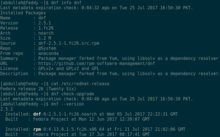DNF (software)
 | |
 DNF running on Fedora 26 | |
| Developer(s) | Red Hat |
|---|---|
| Initial release | 18 January 2012[1] |
| Stable release | |
| Repository | |
| Written in | C, C++, Python |
| Operating system | Linux, IBM AIX |
| Platform | RPM |
| Available in | English |
| Type | Package management system |
| License | GPLv2+ & LGPLv2.1+ & New BSD License |
| Website | rpm-software-management |
DNF or Dandified YUM[4][5][6] is the next-generation version of the Yellowdog Updater, Modified (yum), a package manager for .rpm-based Linux distributions. DNF was introduced in Fedora 18 in 2013;[7] it has been the default package manager since Fedora 22 in 2015,[8] Red Hat Enterprise Linux 8,[9] and OpenMandriva,[10] and is also an alternative package manager for Mageia.
Perceived deficiencies of yum (which DNF is intended to address) include poor performance, high memory usage, and the slowness of its iterative dependency resolution.[11] DNF uses libsolv, an external dependency resolver.[11]
DNF performs package management tasks on top of RPM, and supporting libraries.
DNF was originally written in Python, but as of 2016[update] efforts were under way to port it to C and move most functionality from Python code into the new libdnf library.[12] In 2018, the DNF team announced the decision to move libdnf from C to C++.[13][14] libdnf is already used by PackageKit, a Linux distribution-agnostic package system abstraction library, even though the library does not have most of DNF's features.[15]
Meanwhile, DNF5 is gearing up for an official launch in Fedora Linux 41. This versatile C++ package manager for RPM packages, modules, and comps groups uses libdnf and libsolv, supports Python 3, and is accessible in Fedora 38+.[16]
Adoption[edit]
DNF has been the default command-line package manager for Fedora since version 22, which was released in May 2015.[8] The libdnf library is used as a package backend in PackageKit,[15] which offers a graphical user interface (GUI). Later dnfdragora was developed for Fedora 27 as another alternative graphical front-end of DNF.[17][18] DNF has also been available as an alternate package manager for Mageia Linux since version 6 and may become the default sometime in the future.[19]
In Red Hat Enterprise Linux, and by extension, AlmaLinux and Rocky Linux, yum is an alias for dnf.[9]
Dependencies[edit]
libdnf[edit]
libsolv[edit]
- a free package dependency solver using a satisfiability algorithm for solving packages and reading repositories
- C
- New BSD License
librepo[edit]
- a library providing C and Python (libcURL like) API for downloading Linux repository metadata and packages
- C
- LGPLv2.1+
libcomps[edit]
- libcomps is an alternative for yum.comps library, written in pure C, and has bindings for Python
- C
- GPLv2+
References[edit]
- ^ 0.6.4-1 for rpm-software-management/dnf dnf on GitHub
- ^ a b Tags · rpm-software-management/dnf on GitHub
- ^ a b Tags · rpm-software-management/dnf5 on GitHub
- ^ "DNF". Fedora Project Wiki. Archived from the original on 2018-10-14. Retrieved 2018-05-21.
- ^ "What does DNF stand for". DNF User's FAQ. Archived from the original on 2018-10-14. Retrieved 2018-05-21.
- ^ README.rst · rpm-software-management/dnf on GitHub
- ^ Byfield, Bruce. "Will DNF Replace Yum?". Linux Magazine. Archived from the original on 2015-09-26. Retrieved 2015-05-28.
- ^ a b "Fedora 22 Released, See What's New [Workstation]". WebUpd8. 2015-05-26. Archived from the original on 2015-09-25. Retrieved 2015-05-28.
- ^ a b Matteson, Scott (2019-03-30). "What's new with Red Hat Enterprise Linux 8 and Red Hat Virtualization". TechRepublic. Archived from the original on 2019-09-24. Retrieved 2019-09-24.
- ^ "Switching to RPMv4". OpenMandriva. 2018-03-07. Archived from the original on 2022-06-26. Retrieved 2022-04-15.
- ^ a b Edge, Jake (2014-01-15). "DNF and Yum in Fedora". LWN.net. Archived from the original on 2015-09-30. Retrieved 2015-03-29.
- ^ Šilhan, Jan (2016-02-24). "DNF into C initiative started". DNF blog. Archived from the original on 2017-07-02. Retrieved 2017-07-05.
- ^ Mach, Daniel; Mracek, Jaroslav (22 March 2018). "Announcing DNF 3 development". DNF: A Blog of The DNF Team. Archived from the original on September 18, 2018. Retrieved 8 August 2023.
- ^ Edge, Jake (28 March 2018). "DNF 3: better performance and a move to C++". LWN.net. Archived from the original on October 14, 2018. Retrieved 8 August 2023.
- ^ a b Aleksandersen, Daniel (2017-07-05). "Use DNF rather than PackageKit on Fedora". Ctrl blog. Archived from the original on 2017-08-07. Retrieved 2017-08-07.
- ^ "Changes/ReplaceDnfWithDnf5". Archived from the original on 2023-11-12. Retrieved 2023-11-12.
- ^ "Changes/Replace yumex-dnf with dnfdragora - Fedora Project Wiki". fedoraproject.org. Archived from the original on 2021-09-27. Retrieved 2021-09-27.
- ^ "F27 Self Contained Change: Replace Yumex-DNF with dnfdragora - devel - Fedora Mailing-Lists". lists.fedoraproject.org. Archived from the original on 2021-09-27. Retrieved 2021-09-27.
- ^ Larabel, Michael (2016-09-05). "Mageia To Offer DNF, But Will Keep Using URPMI By Default". Phoronix. Archived from the original on 2017-12-06. Retrieved 2017-12-04.
